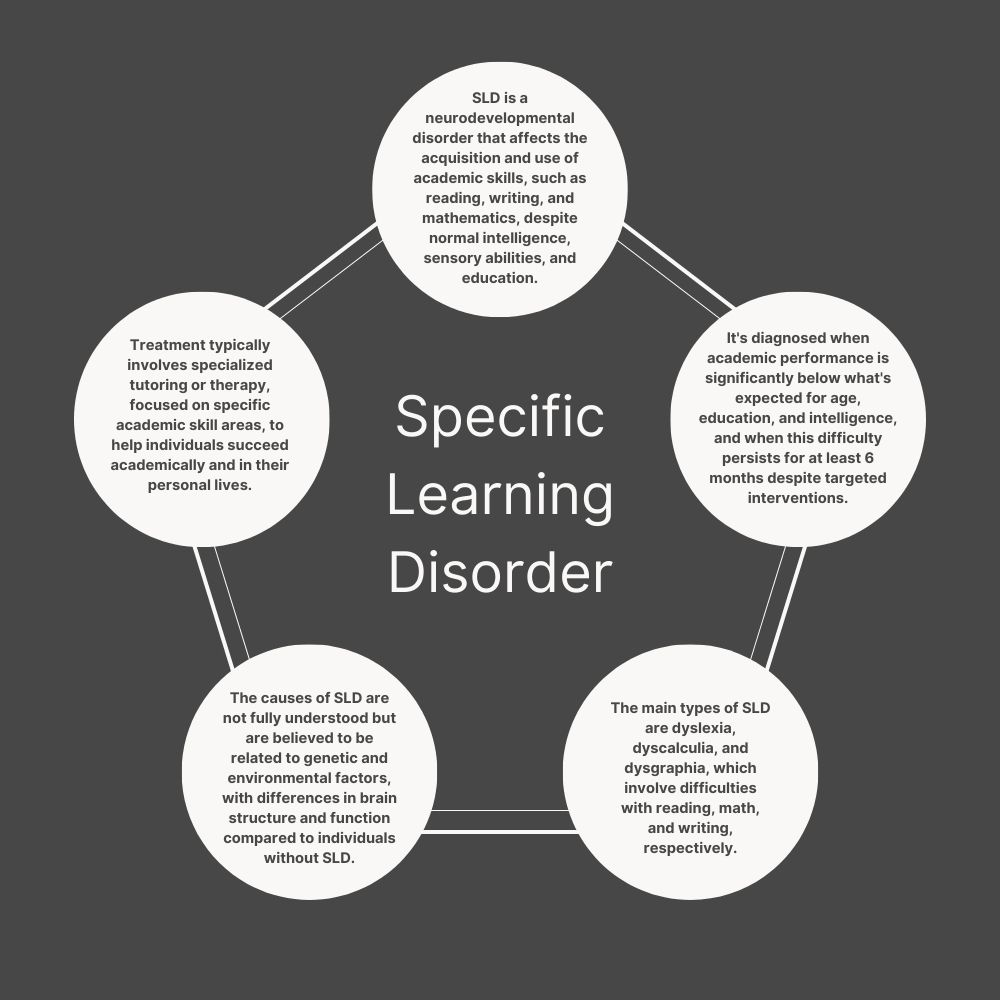What is Specific Learning Disorder?

It is a Neurodevelopmental disorder characterized by an inability to achieve in a designated area of learning at a level consistent with the person’s overall intellectual functioning. Typically, a child will have learning problems in one or more areas: reading (Dyslexia), mathematics (Dyscalculia), or writing (Dysgraphia).
Interestingly, this disorder has a biological origin which includes genetic, epigenetic, and environmental factors, which affect the brain’s ability to pick up or process information efficiently and accurately.
The essential feature: Problem in acquiring or learning academic skills as quickly or as accurately as peers during the years of formal schooling.
Some Facts about SLD:
- SLD is one of the most frequently diagnosed Neurodevelopmental Disorders.
- According to recent statistics, an estimated 5% to 15% of school children experience some form of learning disorder. Without proper treatment, this can lead to them falling behind in school and harm their mental health.
- SLD commonly occurs with other neurodevelopmental disorders like ADHD, communication disorders, and autistic spectrum disorder, or other mental disorders like anxiety and depression.
- SLD interferes with how children take in and process information. If they have issues with incorrect or incomplete schoolwork, it may not be because they “aren’t focusing” or “not trying hard enough” — it’s probably a result of SLD.
- Recognition and diagnosis of specific learning disorder usually occurs during the elementary/primary school years when children are required to learn to read, spell, write, and learn mathematics.
Risk Factors
- Premature birth or very low birth weight
- Prenatal exposure to nicotine (first & second hand smoking)
- Family history of SLD
- Malnutrition
- Lack of engagement by parents or caregivers
Signs & Symptoms
The learning difficulties show as an array of observable and persistent symptoms that evolve over time.
The common complaints from parents and/or teachers are: writing slowly, cannot complete classwork and homework, poor handwriting, in exam omits long answer questions, cannot complete exam paper in time, writing with lots of spelling mistakes, reading slowly, reading word by word, replacing difficult words with words of similar pronunciation, reading without punctuation, mistakes while doing arithmetic etc.
Types of SLD
Dyslexia
- We can usually identify children with reading disabilities by the age of 7 years (second grade).
- Their reading is very slow, and the letters on the page seem to move around and get mixed up, e.g. “b” in place of “d”
- Most children with reading disability have an appropriate ability to copy from a written or printed text, but nearly all spell poorly.
- They often dislike and avoid reading and writing. They become anxious when confronted with demands that involve printed language.
Dysgraphia
- Struggle early in grade school with spelling words and expressing their thoughts according to age-appropriate grammar.
- Spelling errors, grammatical errors, punctuation errors, poor paragraph organization, and poor handwriting
Dyscalculia
- Common features of mathematics deficit include difficulty learning number names, remembering the signs for addition and subtraction, learning multiplication tables, translating word problems into computations, and performing calculations at the expected pace.
- We can detect most children with mathematics deficits during the second and third grades (the age of 8 years).
How do we diagnose SLD?
- Specialized testing and an evaluation from a mental health professional are important steps in diagnosing SLD.
- The child must have difficulties learning and using academic skills that are substantially below those expected for the individual’s chronological age.
- There mustn’t be another explanation for your child’s symptoms, like vision or hearing problems, not having good quality classroom instructions, or not fully understanding or speaking the language of the instructor, psychosocial adversity or any other mental or medical issue.
How do we treat SLD?
- Early diagnosis and intervention is key to a child’s overall success in school. SLD can be extremely handicapping if not diagnosed and treated early and aggressively.
- Children or teenagers usually need remedial instruction to bolster their academic skills, as well as instruction in developing “attack” skills that will assist them in learning strategies to compensate for the deficits that underlie their condition.
References
- American Psychiatric Association. (2013). Diagnostic and statistical manual of mental disorders: Dsm-5.
- Black , D. W., & Andreasen , N. C. (2013). Introductory Textbook Of Psychiatry (6th ed.). American Psychiatric Publishing.
- Boland, R. J., Verduin, M. L., Ruiz, P., Shah, A., & Sadock, B. J. (2022). Kaplan & Sadock’s Synopsis of Psychiatry. Wolters Kluwer.
- Kommu, John Vijay Sagar. (2009). Specific Learning Disorders. AP J Psychol Med.
- Rowe, S. (2021, May 11). Specific learning disorder: Types, symptoms, causes, treatment. Psych Central. Retrieved December 10, 2022, from https://psychcentral.com/disorders/specific-learning-disorder#next-steps
